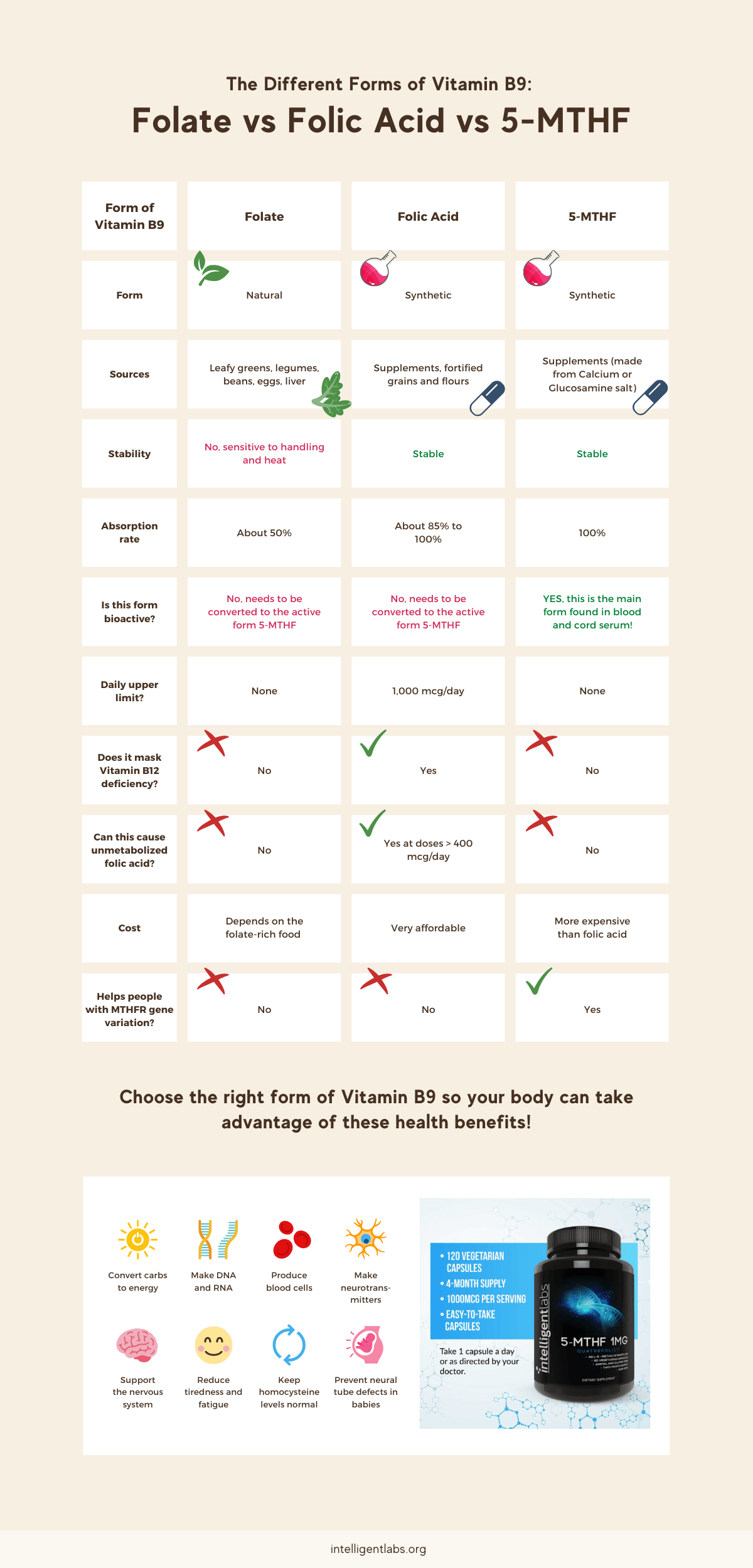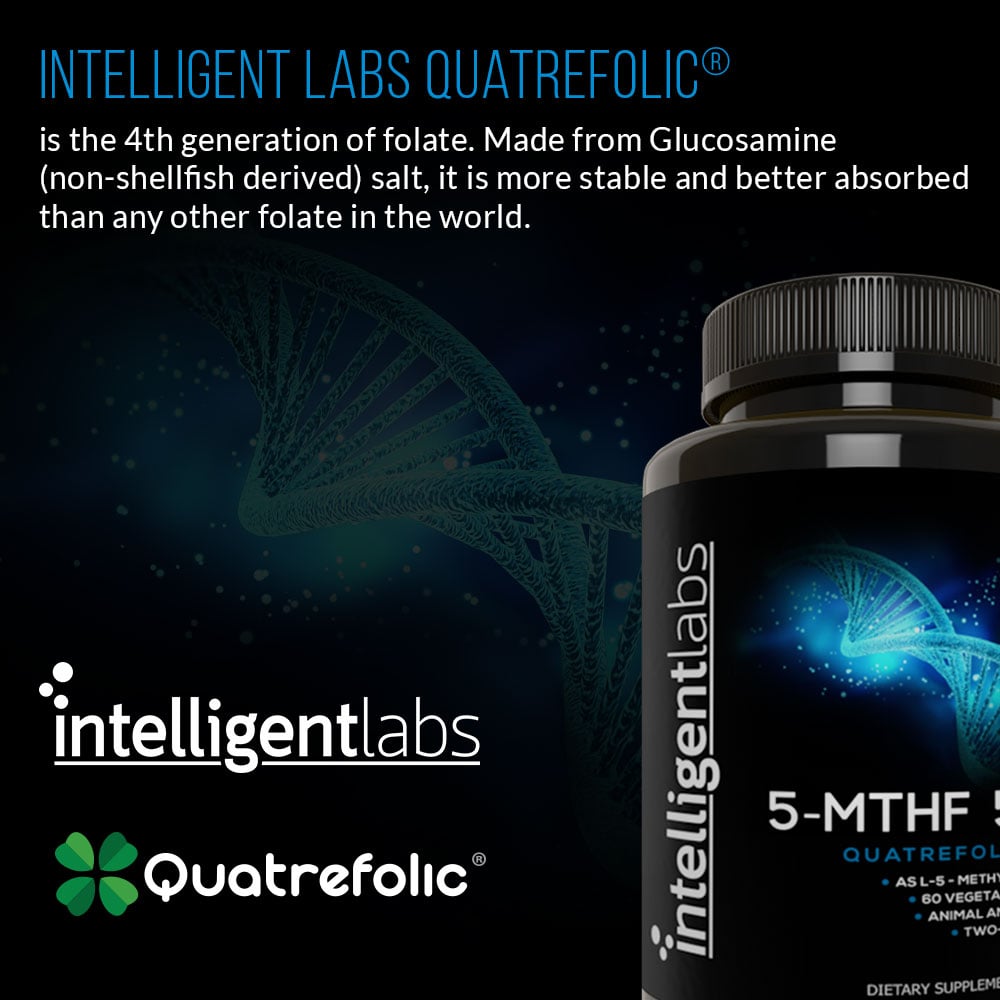Responsible parenting starts long before the baby comes along. Eating a balanced diet, exercising, and taking prenatal vitamins help improve the chances of a healthy pregnancy. In this blog post, we will cover one of the most important vitamins a mom-to-be can take: 5-MTHF activated folic acid.
Table of Contents
Why take folic acid for conception and pregnancy?
For sexually active women, taking folic acid is a must. Too many “accidents” happen, and many women don’t even find out they’re pregnant until a few months later!
121 million unintended pregnancies worldwide occurred from 2015 to 2019. This translates to about 64 unplanned pregnancies per 1000 women aged between 15 to 49 years (1). Unfortunately, unintended pregnancies can be a health risk for both mother and child.
One of the biggest risks of unintended pregnancies is serious birth defects, such as neural tube defects or NTDs. Examples include spina bifida (the spine and spinal cord don’t form properly) and anencephaly (this affects the brain and skull). The good thing is taking enough folic acid before and during pregnancy can prevent NTDs. Sadly though, NTDs remain a problem in many countries worldwide (2).
Fortunately, folic acid fortification can prevent 50-70% of NTDs that occur each year. This is significant because caring for a child born with spina bifida isn’t cheap at all. The estimated lifetime cost for direct care is around $792,000 (3)!
That said, there are different forms of folate and folic acid — they’re NOT all the same! In the next section, we will find out which form of folate is best for women’s prenatal health.

What are the different forms of folate – and what’s best for prenatal health support
The different forms of vitamin B9 are folate, folic acid, and activated folic acid. This vitamin plays a key role in amino acid synthesis, blood formation, homocysteine metabolism, immune system function, and cellular division. It also helps prevent neural tube defects in a developing fetus (4).
The differences between folate, folic acid, and activated folic acid
Folate is the natural form of Vitamin B9. It’s present in a wide variety of foods, such as green leafy vegetables, beef liver, eggs, nuts, fruits, and legumes. It is bioavailable, but incorrect food storage, washing, and cooking can easily destroy the vitamin (5). Folate converts to its biologically active form, 5-MTHF or 5-methyltetrahydrofolate, before entering the bloodstream (6).
Folic acid is the synthetic version of folate. It is more stable than folate, making it the preferred form of Vitamin B9 used in food fortification programs. Examples are breakfast cereals, pasta, bread, flour, and many food supplements.
But there’s a problem with folic acid. Unlike dietary folate, not all folic acid is metabolized and converted to 5-MTHF. This can cause unmetabolised folic acid to build up in the blood, leading to some health problems (7, 8).
This brings us to the next generation of synthetic folate – activated folic acid.
Activated folic acid (5-MTHF) is the main folate form found in the blood. By taking 5-MTHF, your body no longer needs to do any conversions. Why? Because it is already the active 5-MTHF form – the form that dietary folate and regular folic acid get converted to (9).
Activated folic acid is the right form of Vitamin B9 not only for prenatal women, but also for individuals with the MTHFR genetic mutation.
Here’s an infographic outlining the main differences between these 3 forms:

How 5-MTHF can help women (and men) with MTHFR gene polymorphisms
People with the MTHFR genetic variation, specifically the C677T and A1298C variants, have problems metabolizing folate and folic acid. These genetic variants can cause various health problems, such as (10):
- vitamin deficiencies (including low blood folate levels)
- high homocysteine levels (a high risk for heart disease),
- recurring miscarriages, and
- babies with neural tube defects
If you have this MTHFR variation, then taking activated folic acid can help your body make full use of this vitamin.
There are two popular types of activated folic acid:
- L-methylfolate calcium salt – this is activated folic acid from calcium salt
- L-5-Methyltetrahydrofolate (a.k.a. 5-MTHF) – this is activated folic acid from glucosamine salt
So, why is this distinction between these two forms of activated folic acid important?
Well, a 2016 study found that 5-MTHF from glucosamine salt was 1.8 times better absorbed than 5-MTHF from calcium salt. It was also 3.1 times more bioavailable than regular folic acid (11).
Due to its superior bioavailability, activated folic acid from glucosamine salt is the best choice for women of childbearing age. But it’s not limited to women. Anyone with the MTHFR gene polymorphisms can benefit from this form, too!
In our Intelligent Labs 5-MTHF supplements, we use a patented formula called Quatrefolic Acid®. It’s derived from non-shellfish glucosamine salt. Thus making it suitable for vegetarian and vegan consumption.

What are some other benefits of 5-MTHF activated folic acid?
Compared to folate and regular folic acid, activated folic acid is the right choice for pregnant women (12). Here are some notable findings from their research:
- Women with MTHRF mutations show better response to plasma folate markers when taking 5-MTHF, which can help prevent NTD in babies.
- 5-MTHF is more effective than folate and folic acid for pregnancy and postnatal depression.
- Unlike regular folic acid, 5-MTHF does not lead to unmetabolized folic acid in the blood.
- Several studies concur that 5-MTHF is safe, with no side effects reported by pregnant subjects who took 1.13mg/day.
When is the best time to start taking activated folic acid for pregnancy?
According to the CDC, it takes “several months of regular folate consumption to reach blood folate concentration levels high enough to prevent NTDs.”
This means women should start taking 5-MTHF from glucosamine salt a few months before conception until the first trimester of pregnancy as they have higher folate requirements during this period.
Folate is fundamental for fetal growth and development. By having sufficient folate stores prior to conception, NTDs can be prevented, so it is crucial that moms can make full use of the folate they do take (13).
Also, the same thing goes for dads. Men also need to have sufficient folate levels to help ensure a successful pregnancy. Read this to know more about the benefits of folic acid for men.
Final words
Using the right form of folate – in this case, activated folic acid – is important for prenatal health and those having trouble metabolizing dietary folate and folic acid. 5-MTHF’s high bioavailability means you can take advantage of all the amazing health benefits of folate. Check our ultimate guide to folate and 5-MTHF methylfolate here for more information.
As for the best 5-MTHF supplement for pregnancy? Check out our 1MG 5-MTHF and 5MG 5-MTHF supplements in the Intelligent Labs store.




